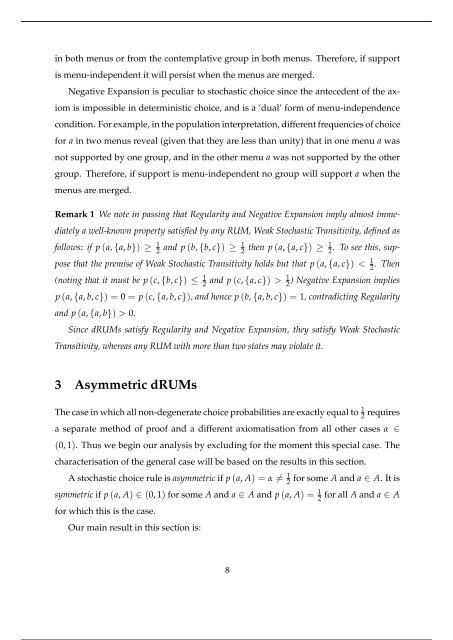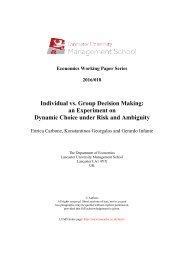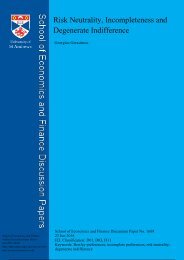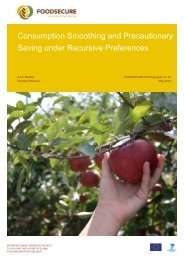Dual Random Utility Maximisation
n?u=RePEc:san:wpecon:1605&r=upt
n?u=RePEc:san:wpecon:1605&r=upt
You also want an ePaper? Increase the reach of your titles
YUMPU automatically turns print PDFs into web optimized ePapers that Google loves.
in both menus or from the contemplative group in both menus. Therefore, if support<br />
is menu-independent it will persist when the menus are merged.<br />
Negative Expansion is peculiar to stochastic choice since the antecedent of the axiom<br />
is impossible in deterministic choice, and is a ‘dual’ form of menu-independence<br />
condition. For example, in the population interpretation, different frequencies of choice<br />
for a in two menus reveal (given that they are less than unity) that in one menu a was<br />
not supported by one group, and in the other menu a was not supported by the other<br />
group. Therefore, if support is menu-independent no group will support a when the<br />
menus are merged.<br />
Remark 1 We note in passing that Regularity and Negative Expansion imply almost immediately<br />
a well-known property satisfied by any RUM, Weak Stochastic Transitivity, defined as<br />
follows: if p (a, {a, b}) ≥ 1 2 and p (b, {b, c}) ≥ 1 2 then p (a, {a, c}) ≥ 1 2<br />
. To see this, suppose<br />
that the premise of Weak Stochastic Transitivity holds but that p (a, {a, c}) < 1 2 . Then<br />
(noting that it must be p (c, {b, c}) ≤ 1 2 and p (c, {a, c}) > 1 2<br />
) Negative Expansion implies<br />
p (a, {a, b, c}) = 0 = p (c, {a, b, c}), and hence p (b, {a, b, c}) = 1, contradicting Regularity<br />
and p (a, {a, b}) > 0.<br />
Since dRUMs satisfy Regularity and Negative Expansion, they satisfy Weak Stochastic<br />
Transitivity, whereas any RUM with more than two states may violate it.<br />
3 Asymmetric dRUMs<br />
The case in which all non-degenerate choice probabilities are exactly equal to 1 2 requires<br />
a separate method of proof and a different axiomatisation from all other cases α ∈<br />
(0, 1). Thus we begin our analysis by excluding for the moment this special case. The<br />
characterisation of the general case will be based on the results in this section.<br />
A stochastic choice rule is asymmetric if p (a, A) = α ̸=<br />
2 1 for some A and a ∈ A. It is<br />
symmetric if p (a, A) ∈ (0, 1) for some A and a ∈ A and p (a, A) = 1 2<br />
for all A and a ∈ A<br />
for which this is the case.<br />
Our main result in this section is:<br />
8






